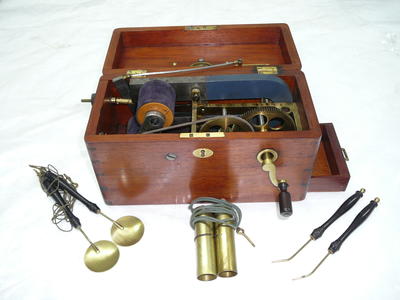Shock Treatment Unit
Maker and role
The Cavendish Electrical Company Limited, Manufacturer
Production date
Circa 1800
See full details
Object detail
Accession number
1982.621
Production period
Description
Electric shock machine, contained in a wooden box with hinged lid. An electric current is generated by rotating 2 coils through the magnetic field of a permanent magnet. The ends of the coils are connected to the shaft, one end of which is insulated from the other end. The insulated end of the shaft is in contact with the wide spring strip which is connected to one terminal. The other terminal is connected to the frame of the machine and so to the other shaft end. An intermittent output is obtained by the provision of 2 flats on the insulated end of the shaft and a small spring strip which is connected to the frame. When this spring strip is in contact with the shaft, the coils are short-circuited and no current flows. When contact with the shaft is broken, which occurs when the coils are in the position for cutting the maximum number of lines of magnet force, current flows in the external circuit. The output of the generator is regulated by altering the position of a shorting bar on the permanent magnet.
Brief History
When man-made electricity was new, people had high hopes that it had curative powers. Unlike other ‘magical’ cures, electricity could be felt. Electro-Convulsive Therapy, very popular from 1850-1900, promised to cure most diseases and conditions including mental illness.
The theory behind ECT dates to 1785 when it was common for doctors to induce seizures and fevers, believing that mental illnesses were antagonistic disorders (muscles that inhibit the function of other muscles). Today ECT is seen as a very inhumane method of treatment.
The Davis Kidder Magneto, patented in 1854, is a simple machine which generates electricity using a magnet. The patient held a nickel-plated brass electrode, while the healer applied a second electrode to the ailing body part and cranked the machine. The crank would operate gears rotating two velvet covered coils through the field of the magnet. This generated a current which was conducted through cloth-insulated wires to the electrodes. The strength of the electric shock depended on how quickly the crank was turned.
The current produced is low voltage - using the machine briefly is not unpleasant. Use causes involuntary muscle contractions and though not scientifically proven, was promoted as a treatment for 'nervous and other diseases, toothache, tic-douloreux, neuralgia, and general bodily pain, etc.'
The theory behind ECT dates to 1785 when it was common for doctors to induce seizures and fevers, believing that mental illnesses were antagonistic disorders (muscles that inhibit the function of other muscles). Today ECT is seen as a very inhumane method of treatment.
The Davis Kidder Magneto, patented in 1854, is a simple machine which generates electricity using a magnet. The patient held a nickel-plated brass electrode, while the healer applied a second electrode to the ailing body part and cranked the machine. The crank would operate gears rotating two velvet covered coils through the field of the magnet. This generated a current which was conducted through cloth-insulated wires to the electrodes. The strength of the electric shock depended on how quickly the crank was turned.
The current produced is low voltage - using the machine briefly is not unpleasant. Use causes involuntary muscle contractions and though not scientifically proven, was promoted as a treatment for 'nervous and other diseases, toothache, tic-douloreux, neuralgia, and general bodily pain, etc.'
Marks
.. / Magnetic Indicator Printed
Other name
Electric shock machine
Credit Line
The Cavendish Electrical Company Limited. Circa 1800. Shock Treatment Unit, 1982.621. The Museum of Transport and Technology (MOTAT).


Public comments
Be the first to comment on this object record.